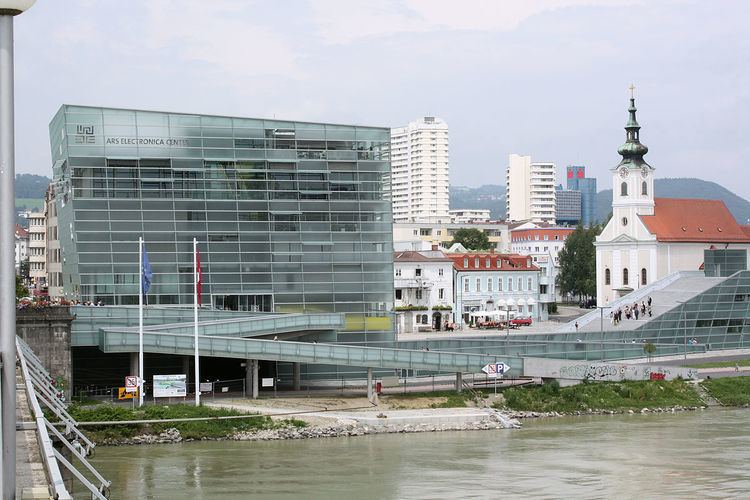Years active 1979– present | Location(s) Austria Founded by Ars Electronica | |
 | ||
Ars Electronica Linz GmbH is an Austrian cultural, educational and scientific institute active in the field of new media art, founded in 1979. It is based at the Ars Electronica Center, which houses the Museum of the Future, in the city of Linz. Ars Electronica’s activities focus on the interlinkages between art, technology and society. It runs an annual festival, and manages a multidisciplinary media arts R&D facility known as the Futurelab. It also confers the Prix Ars Electronica awards.
Contents
History
Ars Electronica began with its first festival in September 1979. Its founders were Hannes Leopoldseder, Hubert Bognermayr, Herbert W. Franke, and Ulrich Rützel. The festival was held biennially at first, and annually since 1986. The Prix Ars Electronica was inaugurated in 1987 and has been awarded every year since then. Ars Electronica Linz GmbH was incorporated as a limited company in 1995. The Ars Electronica Center, together with the Futurelab, opened in 1996, and was remodelled in 2009.
Funding is provided by the City of Linz, the Province of Upper Austria and the Republic of Austria, in addition to private partners. In 2014 the organization is headed by artistic director Gerfried Stocker and financial director Diethard Schwarzmair.
Festival
The annual Ars Electronica festival is a gathering of artists, scientists and technologists, intended as "a setting for experimentation, evaluation and reinvention". The festival has always exerted a public presence in Linz, mounting large-scale open-air projects and holding lectures, discussions and workshops in a wide range of public venues.
Each year the festival is devoted to a specific theme. The festival in 2014, from 4–8 September, had as its theme "C... What it Takes to Change", i.e. ways in which social change and innovation can be promoted. It attracted 579 participants and about 85,000 visitors.
Device art
A form of concept art, Device Art has been described as "...a rebellion of form, taking everyday objects and inverting them to tell you something different". Among the examples exhibited at the 2014 festival were:
Space pixels ("spaxels")
A display called "Smart atoms: spaxels version" was developed by Ars Electronica Futurelab and shown at the 2014 festival. The "space pixels" – automatically controlled drones fitted with LEDs - fly in formation to create apparent three-dimensional objects against the night sky.
Prix Ars Electronica
The Prix Ars Electronica is an annual award made in several categories, "honoring creativity and innovativeness in the use of digital media". Award winners are selected by a five-person international expert jury, who may themselves propose candidates. The prize may be awarded to individuals or to teams or organizations, and may be awarded for a specific work of art or for another form of innovation. Grover (2008) has described the top-ranking award, the Golden Nica, as "the Oscar of digital art".
The Prix was first awarded in 1987, and there have been several changes in the categories since then. In 2014 there were 2,703 entries from 77 countries. All entries remain on display in an online archive, the Prix Ars Electronica Showcase, containing over 55,000 items.
Award categories
Awards of the "Golden Nica" (worth 10,000 euros), "Awards of Distinction", and "Honorary Mentions" are made in the following categories:
Note:
There is also a grant scheme to honor and support ideas of exceptional promise. It is known as "[the next idea] voestalpine Art and Technology Grant".
Some notable award winners
Ars Electronica Center
The Center, also known as the "Museum of the Future", is housed in a modern complex of buildings by the Danube. It acts as Ars Electronica’s permanent base and showcase. The majority of the space is used for public exhibitions and events, with an emphasis on interactivity and participation. Major themes are life sciences, environmental issues, and preparation for impending technological developments with likely impacts on society.
There is also provision for conferences, workshops, and R&D. The Center was enhanced and expanded in 2009, coincident with Linz’s term as European Capital of Culture. It is the most-visited museum in Linz.
Futurelab
The Futurelab, housed at the Ars Electronica Center, is a center of expertise for multidisciplinary research and development of new cyberarts technologies. It is staffed by about 25 permanent team members, and offers residencies to established and emerging artists and researchers.
The Futurelab has produced infrastructure and content for the Center and Festival. More recently it has engaged in joint ventures with universities and the private sector.
The winner of [the next idea] voestalpine Art and Technology Grant is entitled to a term as Artist/Scientist-in-Residence at the Futurelab.
Comment
Trent Nathaniel Grover has included an Appendix about Ars Electronica in his book "Dream of the Techno-Shaman" (2008). He describes the institute’s activities as “a unique platform for exploring, discussing, tracking, and analyzing the interrelation between art, technology, and society”. Such work, he argues, affirms the place of the human being at the center of techno-cultural processes, as “beneficiaries, victims, and, above all, creators and appliers of new technology”. Noting that the rapid pace of technological innovation has profound implications for culture and society, he presents the role of Ars Electronica as working to integrate developments in technology with art and society to the benefit of all, and contrasts this perspective with the Modernist call for "art for art’s sake".
Grover concludes by hoping that Ars Electronica "will be able to maintain its ongoing quest for innovation and expansion so that we can all benefit from and further involve ourselves in the integration of art, technology, and society".
Publications
Grover (2008) has described the published work of Ars Electronica as "a compelling snapshot of codependent technological and artistic development with expansive and lasting social and cultural impact."
